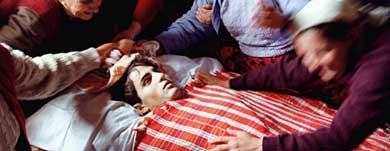"War can be viewed from many angles and portrayed in many different forms, but the only view is of interest to photojournalism is one that emphasizes its meaning." Under this' slogan 'the Spanish journalists Rafael Moreno and Alfonso Bauluz have developed a' jewel 'for lovers of war journalism:' Photojournalists Spanish war "(Ed Turner).
The book, just published in Spain, is a historical journey from 1860 to the present, the best Spanish photographers specializing in coverage of conflicts. The result is very attractive, and agility combined with the profile of each of them with brighter pictures. "It was the most cost: select the best images from many top talent," says Moreno, who also has covered armed conflicts.
The idea came after discovering Bauluz Moreno and there was no historical compilation of Spanish photojournalists in 'mission' of war. As you begin to investigate, confirmed it was true that there was no Spanish photographers featured in the I and World War II (even with the Blue Division), but found there was, and many, during the Spanish Civil War.
"He had always said that the Civil War had portrayed foreigners. But it is not. We have counted more than 30. And on both sides," explains Moreno. Thus it is found in the book, filled with striking images of our tragedy. With the post-war it is clear that there was a vacuum in the world of photojournalism in Spain, which would resurface briefly in the 60's in the hands of Enrique Meneses and his instant famous Fidel Castro and Che Guevara in Sierra Maestra.
But it would be in the 80's when they produce the 'boom' of photographers sent to conflict. "It is no democracy. In Spain you are interested in what happens outside and we photojournalists on all fronts. That itself is a freelance working for foreign media," says Moreno. Turning the pages of 'Photojournalists Spanish war' can be clearly seen.
There are Gervasio Sánchez, Javier Bauluz, Emilio Morenatti or Santiago Lyon. "These are journalists like the top of a pine. Authentic. You can not take pictures from the hotel room," says Moreno. "So we are all a little crazy. They have a great sensitivity, but also a great physical toughness and a great character." Currently, photojournalism maintains its peak.
"In times of crisis, war, is more relevant," said Moreno, who calls the current Spanish photojournalist "very multimedia and professional excellence. "They deserved this vindication of his work," sentence. 


The book, just published in Spain, is a historical journey from 1860 to the present, the best Spanish photographers specializing in coverage of conflicts. The result is very attractive, and agility combined with the profile of each of them with brighter pictures. "It was the most cost: select the best images from many top talent," says Moreno, who also has covered armed conflicts.
The idea came after discovering Bauluz Moreno and there was no historical compilation of Spanish photojournalists in 'mission' of war. As you begin to investigate, confirmed it was true that there was no Spanish photographers featured in the I and World War II (even with the Blue Division), but found there was, and many, during the Spanish Civil War.
"He had always said that the Civil War had portrayed foreigners. But it is not. We have counted more than 30. And on both sides," explains Moreno. Thus it is found in the book, filled with striking images of our tragedy. With the post-war it is clear that there was a vacuum in the world of photojournalism in Spain, which would resurface briefly in the 60's in the hands of Enrique Meneses and his instant famous Fidel Castro and Che Guevara in Sierra Maestra.
But it would be in the 80's when they produce the 'boom' of photographers sent to conflict. "It is no democracy. In Spain you are interested in what happens outside and we photojournalists on all fronts. That itself is a freelance working for foreign media," says Moreno. Turning the pages of 'Photojournalists Spanish war' can be clearly seen.
There are Gervasio Sánchez, Javier Bauluz, Emilio Morenatti or Santiago Lyon. "These are journalists like the top of a pine. Authentic. You can not take pictures from the hotel room," says Moreno. "So we are all a little crazy. They have a great sensitivity, but also a great physical toughness and a great character." Currently, photojournalism maintains its peak.
"In times of crisis, war, is more relevant," said Moreno, who calls the current Spanish photojournalist "very multimedia and professional excellence. "They deserved this vindication of his work," sentence.


- Luz Teodora Guerra Chamorro : Peru (01/06/2011)
- Martin Leonidas Guerra Guerra : Peru (18/03/2011)
- Feature My Bag: @LeticiaGuerra Louis Vuitton Vernis (13/05/2011)
- Guerra de la Paz (16/04/2011)
- Funky Rope Sculptures - Mozart Guerra Creates Modern Busts of Animals and People (TrendHunter.com) (10/05/2011)
No comments:
Post a Comment